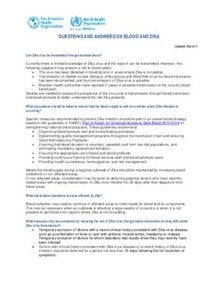This document, last updated on March 04, 2016, answers the following questions:
- Can Zika virus be transmitted through donated blood?
- What precautions should be taken to ensure that the blood supply is safe in countries where Zika infection is occurring?
- What about blood donations in areas affected by Zika?
- What measures may be considered for reducing the risk of Zika virus through blood transfusion in areas with active Zika virus transmission?
- How could blood donations be tested for the presence of Zika virus?
- Should countries prepare if they have Aedes mosquitoes but the Zika virus has not yet been found?
Can Zika virus be transmitted through donated blood?
Currently there is limited knowledge of Zika virus and the ways it can be transmitted. However, the following suggest it may present a risk to blood safety.
- The virus has been detected in blood donors in areas where Zika is circulatin
- Transmission of related viruses (dengue, chikungunya and West Nile virus) by blood transfusion has been documented, and thus transmission of Zika virus is possibl
- Brazilian health authorities have reported 2 cases of possible transmission of the virus by blood transfusion
Studies are needed to assess the prevalence of the virus and of transmission through blood transfusion and blood products to better understand the risk Zika presents.
What precautions should be taken to ensure that the blood supply is safe in countries where Zika infection is occurring?
Specific measures recommended to prevent Zika infection should be part of an overall blood strategy based on the guidelines in PAHO’s Plan of Action for Universal Access to Safe Blood 2014-2019 for strengthening national blood programs. These guidelines recommend Organizing blood services well and concentrating processes.
- Implementing quality management programs throughout the transfusion chain and ensuring Good Manufacturing Practices
- Ensuring that blood donation is voluntary, repeated, and from low-risk populations, and eliminating mandatory replacement donation
- Ensuring the appropriate use of blood and blood products
- Providing continuous training for blood services staff and blood products user
- Providing health surveillance, hemovigilance, and risk management
Ideally the blood supply during a regional outbreak of Zika should be maintained by increasing blood collections in non-affected areas. In non-affected areas, consideration may be given to deferring potential donors who have recently visited areas with ongoing transmission of Zika virus infection for 28 days after their departure from these areas.
What about blood donations in areas affected by Zika?
Blood collection may need to continue in affected areas to meet needs for blood and its components. This may be necessary when an outbreak is affecting a large swathe of a country or when it is not possible to get blood from regions where Zika is not circulating.
What measures may be considered for reducing the risk of Zika virus through blood transfusion in areas with active Zika virus transmission?
- Temporary exclusion of donors with a recent clinical history consistent with Zika virus disease, such as a combination of fever or rash with pinkeye, muscle aches, headache or malaise. Temporary exclusion of donors for whom laboratory test results show they may recently have been infected
- Donors with clinical history consistent with Zika virus disease or a recent history of Zika virus infection should be deferred for a period not less than 28 days following the full resolution of symptoms
- Similarly, sex partners of men with confirmed or suspected Zika virus infection in the last 3 months should be deferred for at least 28 days after their last sexual contact
- People who have already donated must be encouraged to report to the blood transfusion service if they subsequently get symptoms of Zika virus infection, or if they are diagnosed with recent Zika virus infection within 14 days after blood donation
- Blood components of appropriate shelf life (e.g. red blood cells) may be quarantined for a period of 14 days and released following confirmation from the donor that he or she has not experienced symptoms consistent with the acute phase of Zika virus infection
- Blood banks should provide information to donors on Zika virus infection and encourage them to report any symptoms they might develop up to 14 days after donating blood
- Countries with many visitors to affected countries may need to assess the impact of deferral on blood supply availability and weigh the risks against the benefits of restricting donations
- It is important to monitor patients who receive transfusions from donors who develop symptoms or receive a laboratory diagnosis of Zika infection. Haemovigilance for transfusion patients who receive a clinical or laboratory diagnosis of Zika infection should be intensified.
How could blood donations be tested for the presence of Zika virus?
Where possible, blood donations may be tested for the presence of Zika virus by appropriate tests. Viral inactivation or pathogen reduction technology (PRT) may be implemented for plasma and platelets. In some cases, selective testing—where possible, nucleic acid testing (NAT)—for the presence of the virus in blood donors returning from affected countries may be considered as an alternative to deferral.
Should countries prepare if they have Aedes mosquitoes but the Zika virus has not yet been found?
WHO recommends that countries where the mosquito that carries Zika exists, yet the virus itself has not been found, consider preparing a contingency and risk management plan to ensure the availability of a safe and sufficient supply of blood should an outbreak occur.
For more information: Provisional recommendations for blood services in light of the Zika virus epidemic
|

